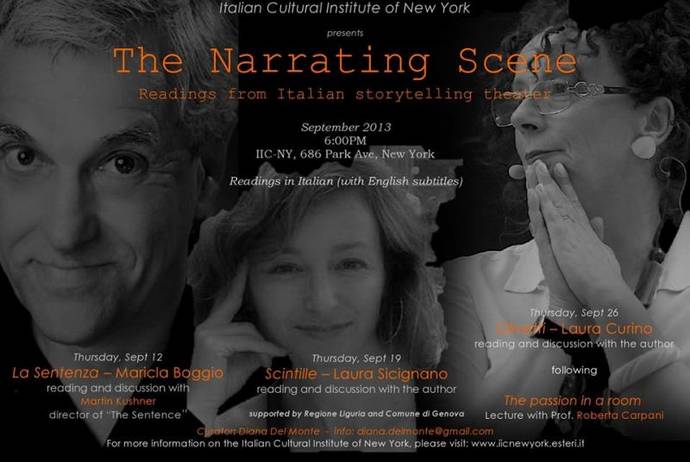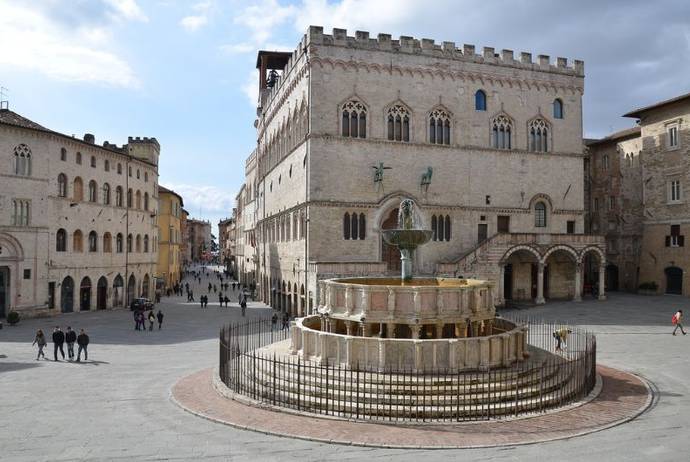The passion can really be all in one room, and fill it completely. As Diana Del Monte, Curator
of the series of theatrical events Narrating Scene. Readings from Italian Storytelling Theatre at the Italian Cultural Institute of New York, said during her introduction yesterday night, “The Passion in a Room is a very appropriate title for the lecture” (by prof. Roberta Carpani, ndr) that follow through Olivetti: Toward the Origins of a Dream by Laura Curino.
i-Italy had the pleasure to interview Diana Del Monte, Curator of this important theatrical project part of the year of the Italian Culture in the US. An interesting selection of theatrical works by Maricla Boggio, Laura Sicignano and Laura Curino were hosted at the Italian Cultural Institute for three consecutive Thursdays, starting from September 12th to September 26th.
Diana’s background demonstrates her inner capacities and interest in performing arts. Diana has been working for 7 years as a researcher and dance/theater critic and in the meantime she gained a Bachelor Degree in History of Theater and a Master in Performing Arts, with a published thesis on the anthropology of dance; she is also currently finishing her Phd on communication, media and performing arts at the prestigious Catholic University of Sacred Heart in Milan.
Diana, Tell me about the project you curated at the Italian Cultural Institute of NY.
The Italian Cultural Institute in New York has hosted in these years events of great quality. However, the theater had been, until last year, in the shade compared to other sectors. Therefore, in February, I decided with the precious help of Fabio Troisi, Attache for Cultural Affairs - Cinema, Art, Music, Dance and Theatre of the Italian Institute, to create this theater project, that can be considered innovative and different.
Why do you consider this project innovative and different?
First of all, because it is not a single event but it is a series of events, it is structured thinking about an American audience, however, it is in Italian. Then we decided the theme, the theater of contemporary Italian narrative, and the presence of subtitles. It was an experiment.
The basic idea of Narrating Scene was to inform and divulgate to an International audience the knowledge of one of the most interesting and vibrant Italian contemporary theater genres and at the same time to support the divulgation of the Italian language, as directed by the Farnesina, in the year of the Italian culture in the US.
Did it work?
The Italian language with its musicality and the amazing interpretation of the artists was capable to hypnotize and make flow the imaginations of both the Italian and the American guests.
The public response to the events had been very satisfactory; even those who were not Italian speakers enjoyed the performances very much and they congratulated with me and the rest of the staff. Therefore, I believe that this project that was born as an experiment can be considered a great success, especially considering the limited budget we had.
How did you come up with this idea?
Some personal events and the support of the Italian Institute that believed in my ideas. The project had three strengths. First the renowned artist present at the events. We had the honor to collaborate with three excellences of the Italian Theatre, Maricla Boggio playwright and theatre Critic, Laura Sicignano playwright and Director of Cargo’s Theater of Genova and Laura Curino theater actress and playwright, considered the mother of the Italian contemporary theater. Three women and amazing artists, with different backgrounds and approaches to the theater.
In addition, it is a theatrical genre strong and close to people who have been able to innovate, to find new audiences and new spaces… in the centuries. Its roots are from “Cunto Siciliano”…the Italian traditions. Curino was invited to perform in front of President Napolitano and Scignano in front of Minister Kyenge. It is a theater genre that had found its own space also in the Mass Media, RAI has transmitted several times in fact pieces of Theatre Storytelling, with very strong audience response.
Which are the other “strengths”?
The second is the educational aspect. We can consider Narrating Scene as a project directed for the education of the public. In my researches I had always approached art from the socio-anthropologic point of view. For this reason I strongly believe in the relation with the audience. Education is fundamental. Education means learning. Learning means understanding, Understanding means you can love it… Maybe…Sometimes…(Diana smiled)
In New York you can find lots of Italian theater festivals and performances. Narrating scene was thought as an educational project not as a Festival. Therefore, It does not replace or opposes Festival and programming of the Italian theater but is born as an idea to rather support them, through the education of the American public.
Tell me about the last “strength”.
The last strength is the most important for me, the multicultural dialogue. It is important to educate our international audience in the historical and social aspect of the Italian theatre to make them learn about it, about us, about our Country. As an artistic point of view this theatre is characterized by social commitment and these theatrical performances have the power to create a sense of belonging and group identity.
The three performances we hosted were capable to connect Italian, Italian-American and American that love Italy and want to know more about it.
La sentenza talks about people who live in a condition of war, many could identify with it.
Scintille, narrates from the point of view of Italian victims, the stake of T.W.C. in New York in 1911. Olivetti, tells the story of an Italian entrepreneur and the realization of his dream.
Would you like to add any comments?
I would like to thank all the people that helped me in the realization of this project, it is also thanks to them that we had a wonderful audience response.
During the interview I was impressed by Diana’s passion for the project she personally curate it since last February with a deep commitment and dedication and I honestly believe that the key element to make “The Narrating Scene” project bright so much has been based on her extraordinary talent combined with her brilliant personality and the magnificent support of the rest of the staff .







































